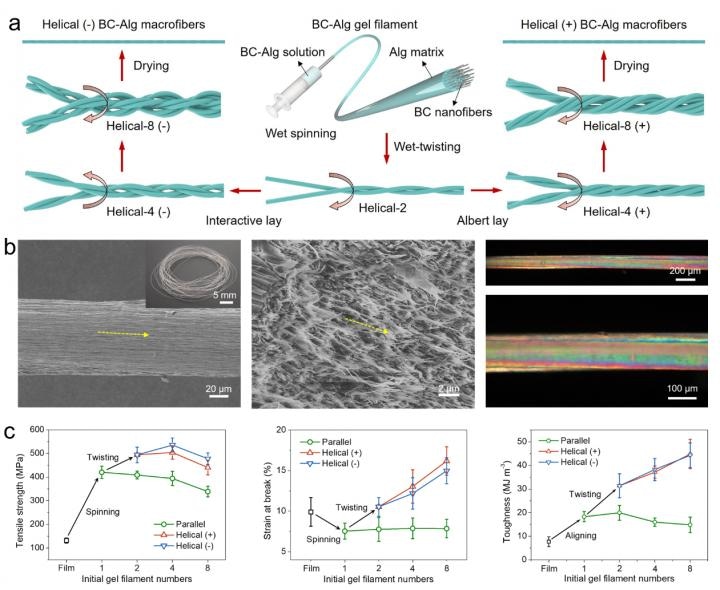The renewable, eco-friendly, and sustainable characteristics of high-performance biomass-based nanocomposites have helped them emerge as potential materials for future structural and functional applications.
 Schematic illustration of the fabrication process (a), structural characterization (b), and mechanical investigation (c) of the bioinspired hierarchical helical nanocomposite fibers. (Image credit: Science China Press)
Schematic illustration of the fabrication process (a), structural characterization (b), and mechanical investigation (c) of the bioinspired hierarchical helical nanocomposite fibers. (Image credit: Science China Press)
Bio-sourced nanocelluloses (a type of nanofiber) derived from plants and bacterial fermentation are the most plentiful raw materials on earth.
In recent times, they have gained great attention owing to their attractive inherent benefits including low density, biodegradability, global availability from renewable resources, thermal stability, and also remarkable mechanical properties. These features make them highly suitable building blocks for spinning the next generation of sophisticated macrofibers for practical applications.
Over the last 10 years, different approaches have been followed to obtain cellulose-based macrofibers with better stiffness and strength. However, almost all of them have achieved at the cost of toughness and elongation, since toughness and strength are always mutually exclusive for artificial structural materials. Thus, this predicament is rather usual for cellulose-based macrofibers reported earlier, which significantly restricted their practical applications.
Recently, in a new article published in the National Science Review, a bionics research group headed by Prof. YU Shuhong from the University of Science and Technology of China (USTC) got inspired to solve this issue from biological structures.
They discovered that the prevalent biosynthesized fibers, for example, some plant fibers, animal hairs, and spider silk, all have some common characteristics. They are strong as well as tough, and possess hierarchical helical structures across multiple length scales with strong and firm nanoscale fibrous building blocks ingrained into soft and energy dissipating matrices.
Drawing inspiration from these structural features in biosynthesized fibers, the research team proposed a design strategy to produce nanocellulose-based macrofibers with comparable structural features. They employed sodium alginate as the soft matrix and bacterial cellulose nanofibers as the rigid and tough building blocks.
By integrating a simplistic wet-spinning process with a subsequent multiple wet-twisting procedure, they were successful in obtaining biomimetic hierarchical helical nanocomposite macrofibers and achieved notable enhancement of their elongation, tensile strength, and toughness at the same time as anticipated.
This achievement confirms the validity of their bioinspired design and offers a prospective path for further developing several other tough and strong nanocomposite fiber materials for a variety of applications.
Source: http://www.scichina.com/

